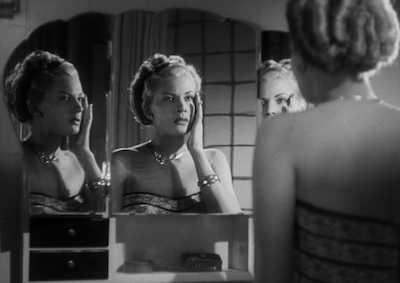Admission is free. No advance reservations. Seats are available on a first come, first served basis. Hammer Museum members will have reserved seating available at the box office. The box office opens one hour before the first program of the day.
Never Open That Door
No abras nunca esa puerta, Argentina, 1952
The title guides us not to open the door, but twice we enter through it into the lives of upper-class Argentine families facing desperate familial conflicts in No abras nunca esa puerta. The two-part film noir opens with the segment “Somebody on the Phone,” featuring siblings Luisa (Renée Dumas) and Raúl Valdez (Ángel Magaña), who live closely (maybe too closely?) in their family’s spacious, decadent Buenos Aires apartment. Luisa, the younger sister, faces a dire situation in which Raúl becomes entangled while trying to save her. The second segment, “Hummingbird Comes Home,” centers on Rosa (Ilde Pirovano), a blind woman who awaits the return of her mysteriously vanished adult son (Roberto Escalada). When he suddenly returns, Rosa finds herself truly submerged in darkness.
The original stories adapted here were written by American crime author Cornell Woolrich (as William Irish). The gloom and desperation seen in Woolrich’s stories are reminiscent of his own despondent life spent mostly in reclusion with his mother. A third grim Woolrich story was intended as the final segment in No abras nunca esa puerta but became the stand-alone feature Si muero antes de despertar (If I Die Before I Wake, 1952) by the same director, Carlos Hugo Christensen. Soon after making these films, Christensen was exiled for opposing Argentine authoritarian-populist president Juan Perón and immigrated to Brazil, where he continued a career in film through the 1990s.
In the ’40s and ’50s, Christensen worked on several films with Argentine film icons Roberto Escalada and Nicolás Fregues, both of whom appear in this all-star cast. Their presence adds to the maze of shadows and gut-wrenching confusion that made No abras nunca esa puerta one of the most celebrated noir thrillers to come out of Argentina’s golden era of cinema.—Nicole Ucedo
DCP, b&w, in Spanish with English subtitles, 85 min. Director: Carlos Hugo Christensen. Screenwriter: Alejandro Casona. Based on the short stories “Somebody on the Phone” and “Hummingbird Comes Home” by Cornell Woolrich (as William Irish). With: Ángel Magaña, Renée Dumas, Ilde Pirovano, Roberto Escalada, Nicolás Fregues.
Restoration funded by the Golden Globe Foundation and the Film Noir Foundation. Restored by the UCLA Film & Television Archive from a 35mm dupe picture negative, a 35mm subtitled print and a 16mm print. Laboratory services by Roundabout Entertainment, Inc. Special thanks to Argentina Sono Film, Luis Scalella; Malba Museo de Arte Latinoamericano de Buenos Aires; Fernando Martin Peña.
Special thanks to our community partners: Arthur Lyons Film Noir Festival, Consulate General of Argentina in Los Angeles, El Cine, Latin American Cinemateca of Los Angeles, Palm Springs Cultural Center, UCLA Chicano Studies Research Center, UCLA International Institute.






 Mobile Navigation
Mobile Navigation

